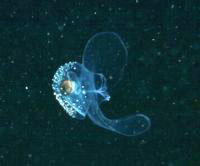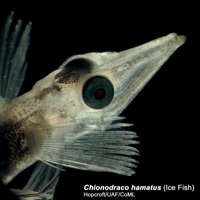Navigation
Census of Marine Life Explorers Find Hundreds of Identical Species Thrive in Both Arctic and Antarctic
Started in the year 2000, Census of Marine Life (CoML) is an international science research program uniting thousands of researchers worldwide with the goal of assessing and explaining the diversity, distribution and abundance of marine life - past, present and future - by 2010.
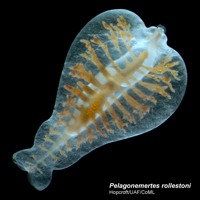 |
| The nemertean Pelagonemertes rollestoni, hunts for zooplankton prey that it will harpoon with a dart attached to the tongue coiled within it. It yellow stomach reaches out to feed all parts of the body. About 3 cm long, it was photographed during the CEAMARC 2008 expedition aboard the Umitaka Maru to the Antarctic, part of a joint CAML/ArcOD/CMarZ effort. Credit: Russ Hopcroft, University of Alaska Fairbanks, Census of Marine Life. |
Started in the year 2000, Census of Marine Life (CoML) is an international science research program uniting thousands of researchers worldwide with the goal of assessing and explaining the diversity, distribution and abundance of marine life - past, present and future - by 2010.
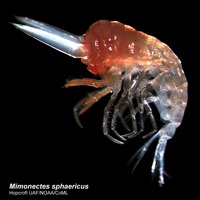 |
| Mimonectes sphaericus is a commensial amphipod crustacean living upon jellyfish and their kin in both the Arctic and Antarctic. The large sword-like antennae only occur on males. Credit: Russ Hopcroft, University of Alaska Fairbanks, Census of Marine Life. |
Earth's unique, forbidding ice oceans of the Arctic and Antarctic have revealed a trove of secrets to CoML explorers, who were especially surprised to find at least 235 species live in both polar seas despite an 11,000-kilometer distance in between.
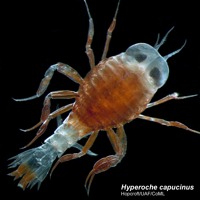 |
| Sand-fleas such as Hyperoche capucinus, are common predators swimming in polar waters. This specimen, about the width of a finger, was photographed during the CEAMARC 2008 expedition aboard the Umitaka Maru to the Antarctic, part of a joint CAML/ArcOD/CMarZ effort. Credit: Russ Hopcroft, University of Alaska Fairbanks, Census of Marine Life. |
The scientists found marine life that both poles apparently share in common include long distance travelers such as grey whales and not only birds, but also worms, crustaceans, and angelic snail-like pteropods, the latter discoveries opening a host of future research questions about where they originated and how they wound up at both ends of the Earth. DNA analysis is underway to confirm whether the species are indeed identical.
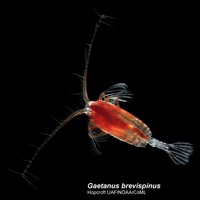 |
| The copepod Gaetanus brevispinus has a world-wide distribution, but is most commonly collected in polar waters where its cold-water habitat comes closer to the ocean’s surface. In mid-latitudes it occurs as deep as 3000 m. Credit: Russ Hopcroft, University of Alaska Fairbanks, Census of Marine Life. |
Among many other findings, the scientists also documented evidence of cold water-loving species shifting towards both poles to escape rising ocean temperatures.
The discoveries are the result of a series of landmark, often perilous voyages conducted during International Polar Year (IPY), 2007-2008.
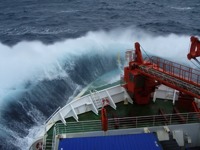 |
| Census explorers often dangerous conditions from icy decks, huge waves, to encounters with polar bears to advance knowledge about marine life in the polar regions. Credit: Victoria Wadley, Australian Marine Science, Census of Marine Life. |
Biologists braved waves of up to 16 meters (48 feet) while getting to and from the Antarctic while their Arctic colleagues often worked under the watchful eye of an armed lookout to protect them from polar bears.
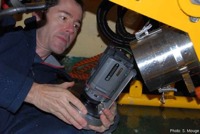 |
| A remotely operated vehicle equipped with a video camera was used to record life in the Southern Ocean during an expedition aboard the Aurora Australis. Shown here is scientist Rob Beaman removing the camera from its waterproof case. Credit S. Mouge |
The studies by a global network of polar researchers have added substantially to human knowledge about the diversity, distribution and abundance of marine life, with results to be fully detailed in the world's first Census report, to be released in London Oct. 4, 2010.
"The polar seas... teem with an amazing quantity and variety of life," says Dr. Ian Poiner, Chair of the Census Scientific Steering Committee. "Only through the co-operation of 500 people from more than 25 countries could the daunting environmental challenges be overcome to produce research of such unprecedented scale and importance. And humanity is only starting to understand the nature of these regions."
“It is clear to us working in the CoML every time we learn more about the ocean systems it becomes more complex,” says Ron O’Dor, Senior Scientist for Census. “The ocean as a habitat is incredibly complex; we need to have a better understanding of what is in the oceans. We know we need to have time series so one census is not going to be enough.” He added that the Census is working to be part of the United Nations’ planned regular marine assessments to be able to ascertain the state of the oceans.
The polar Census teams are documenting:
- The distribution of ocean animals - mapping their changing ranges and hotspots;
- The diversity of species (to date: 7,500 animals in the Antarctic and 5,500 in the Arctic, of a global marine life species total estimated at 230,000-250,000); and
- The abundance and sizes of major species groups at various levels in the food web, in order to gauge how they change over time.
Antarctic seafloor: a single bioregion and a cold incubator for new species
Previously thought to be low in species diversity and abundance, Census of Antarctic Marine Life (CAML) researchers and collaborators have amassed biological data from nearly 1 million locations. Those places include seafloors exposed to light for the first time in as much as 100,000 years when ancient ice shelf lids melted and disintegrated in recent years.
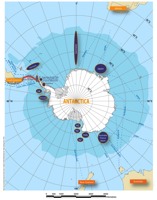 |
| Census of Antarctic Marine Life ship tracks during International Polar Year (IPY), which ran from March 2007-March 2009. |
Led by Drs. Michael Stoddart and Victoria Wadley of the Australian Antarctic Division, and Dr. Colin Summerhayes, Executive Director of the Scientific Committee on Antarctic Research, the CAML coordinated 18 major research voyages during IPY 2007-2008, the tracks of the voyages shown at right.
The extensive sampling has provided both an immediate picture of unexpectedly rich marine life around Antarctica and the means to test important theories.
Research in the 1970's suggested separate bioregions around Antarctica. CAML's efforts, however, reveal life on the seafloor encircling Antarctica forms a single biological province, even though 8,500 km of ocean separates opposite sides of the continent.
Scientists are now analyzing hundreds of open ocean (pelagic) samples from all compass points around Antarctica to establish whether, as suspected, marine life distribution has been evened by the churn of the Antarctic Circumpolar Current. That swift-flowing current circles the polar continent twice as fast as the Gulf Stream flows from the Gulf of Mexico towards Europe.
And they report species of cold-water snail (pteropods) migrating southward as ocean temperatures rise further north.
Meanwhile, the polar marine explorers were startled when molecular techniques revealed that glacial cycles over millions of years made the Antarctic the cold incubator of many species residing today in more northern waters.
Census researchers last year established that several octopus types have repeatedly colonized the deep sea, each migration coinciding with retreating Antarctic ice over 30 million years.
Today they theorize that the Antarctic also regularly refreshes the world's oceans with new varieties of sea spiders, isopods (crustaceans related to shrimp and crabs), and others as well. They believe the new species evolve when expansions of ice cloister Antarctica; when the ice retreats, they radiate northward along the same pathways followed by the octopuses.
The abundance of Antarctic marine biodiversity is recorded in the SCAR-MarBIN database, which today contains close to 1 million marine life observations below the Antarctic Circle. About half of Antarctic species are found nowhere else on Earth.
Says Victoria Wadley: "One hundred years ago, Antarctic explorers like Scott and Rutherford saw mostly ice. In 2009, we see life everywhere."
The Arctic: changes recorded
Many global collaborators teamed with the Census' project on Arctic Ocean Diversity (ArcOD), led by Drs. Rolf Gradinger, Bodil Bluhm and Russ Hopcroft of the University of Alaska, and Dr. Andrey Gebruk of the Shirshov Institute, Moscow. Together they completed 14 IPY expeditions, including 10 cruises.
Field work will continue this summer, including a cruise to the Beaufort Sea to investigate the potentially important role sea ice ridges could play as a refuge for marine life if ice loss continues long-term.
ArcOD researchers say subtle effects on marine life distribution, abundance and diversity due to recent warming in the Arctic have started appearing, most notably:
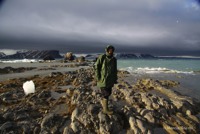 |
| Twenty years ago the shores of inner basins of the Arctic Hornsund fjord (Svalbard archipelago) were barren, as solid fast ice staying in average of 8-9 months per year scoured all the macroorganisms. Today, with the fast ice present no more than 4-5 months algae are climbing up the shore creating a new, rich habitat in the former desert. Marcin Gorski, ArcOD. |
· A rising ratio of warm water to cold water-loving amphipod crustaceans in Hornsund fjord in Norway's Svalbard Island group (also called Spitsbergen, midway between Norway and the North Pole); and
· Documentation from the Chukchi Sea of range extensions to the north of at least three species - in two cases by up to 500 km - plus a growing number of snow crabs.
Meanwhile, researchers say smaller marine species are replacing larger ones in some Arctic waters. The reasons behind the shift are obscure but the implications for the Arctic food web may be profound.
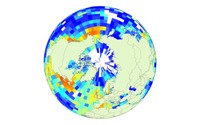 |
| Sampling intensity varies widely at the polar regions. Shown here is northern polar region fish data available in OBIS, the Census database. White indicates areas where little or no data. Red indicates a high value of records are available, blue low. Credit: Edward Vanden Berghe, OBIS. |
The Census database known as OBIS (the Ocean Biogeographic Information System) today contains almost 1 million observations of more than 5,500 distinct taxa in Arctic waters, with more being added at an ever quickening pace.
The map at right depicts the number of records in OBIS for all Arctic marine life, where white indicates no records.
Says Russ Hopcroft: "We have filled in major blank spots on the Arctic map, and continue to add more, though big unobserved areas remain."
New technologies
New technologies are dramatically speeding Census research into the abundance, diversity and distribution of marine biodiversity.
SCUBA divers were deployed for observations in heavy Arctic ice and advanced, deep water optical systems on Remotely Operated Vehicles (ROVs) enabled detailed studies of delicate marine animals too fragile to collect. Similar approaches recorded videos of penguins and seals under Antarctic ice.
Census researchers are using cell phone-like devices to learn about the distribution of large animals at both poles. For example, tracking devices fitted to narwhals, the ocean unicorn, record their Arctic migrations and provide as a by-product a wealth of rich data on the status of polar oceans, lending a major assist to science. Seals, meanwhile, captured before and after observations of the 2008 collapse of a large part of Antarctica's Wilkins ice shelf.
And DNA sequences, or barcodes, will dramatically accelerate the cataloguing of life's diversity, helping to identify new and cryptic species. In partnership with Canada's University of Guelph, ArcOD, CAML, their sister project, the Census of Marine Zooplankton (CMarZ ), and others are collaborating in the Polar Barcode of Life project, with Belgium's SCAR-MarBIN creating data storage, analysis and visualization tools. CAML is barcoding some 3,000 Antarctic species; ArcOD has barcoded about 300 to date. With a completed molecular catalog, analysis of genetic variation within polar marine environments and at different depths will be far quicker and easier.
The outstanding accomplishments of dedicated polar marine researchers, who often brave bitter cold and perilous ocean conditions, have been honored recently in a number of countries. On a 2008 visit to Antarctica, for example, Brazilian President Luiz Inácio Lula da Silva, presented CAML scientist Dr. Lucia Campos with a national award for her work in that region. Researcher Dr. Angelika Brandt of Germany was awarded the prestigious biennial SCAR medal by the Scientific Committee on Antarctic Research. And Census scientists Drs. Eduardo Klein and Elizabeth Huck of the Universidad Simon Bolivar received Venezuela's highest civilian honor for their studies of Antarctic biodiversity.
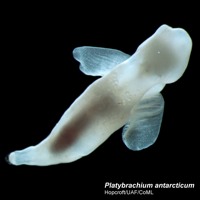 |
| The ghost-like sea-angle Platybrachium antarcticum, flies through the deep Antarctic waters hunting the shelled pteropods (another type of snail) on which it feeds. This 3 cm long slug was photographed during the CEAMARC 2008 expedition aboard the Umitaka Maru to the Antarctic, part of a joint CAML/ArcOD/CMarZ effort. Credit: Russ Hopcroft, University of Alaska Fairbanks, Census of Marine Life. |
Photography by ArcOD team members has earned a place in galleries from Alaska to the Smithsonian Institution in Washington DC, and inspired an exhibition of paintings based on the images. CAML and ArcOD researchers, meanwhile, have both provided marine life photos used for stamps in Canada and Australia commemorating IPY.
Benefits to society accruing already from Census research include the identification of vulnerable marine habitats in the Southern Ocean, based on CAML information. Meanwhile, the marine component of a multi-national Circumpolar Biodiversity Monitoring Program is in development with ArcOD participation. (Now underway, as of 2015, with the Arctic Council.)
Ian Poiner concludes: "In these unique oceans, where the water temperature is colder at the surface than below, we are establishing the first benchmarks of marine biodiversity against which change may be measured, a significant polar year legacy for future generations. The significant investment of nations, the skills of scientists from the many ocean research disciplines, and the social network of the Census of Marine Life made it happen."
******
Among others, of the 17 Census of Marine Life projects contributing to the progress of understanding in polar regions is the International Census of Marine Microbes (ICoMM), which was recently able to sequence the DNA of more than 370,000 individual microbes living in 2-to-10 liter seawater samples drawn from 16 points around the Antarctic. Work is underway to distinguish the species captured.
The History of Marine Animal Populations (HMAP) project researchers, meanwhile, studied monastic and government records dating back to the 1600s to reconstruct populations of walruses in the White and Barents seas.
About the Census of Marine Life
Started in the year 2000, CoML is an international science research program uniting thousands of researchers worldwide with the goal of assessing and explaining the diversity, distribution and abundance of marine life - past, present and future - by 2010.
In 2009, researchers will pursue adventurous expeditions to sample a range of key habitats. They will conduct the first exploration of the world's deepest known ocean volcanoes, for example, found more than 5,000 meters below surface in a Caribbean seafloor rift between Jamaica and the Cayman Islands.
Of particular note also is sampling scheduled in the largely unexplored areas of the Indian Ocean off Madagascar, where experts expect to meet hundreds of new species in all taxonomic groups. Since the mid 1990s, collectors have been intrigued by the seashells of unknown mollusc species offered for sale by local lobster fishermen. Advanced amateurs have since sampled and described more than 35 mollusk species that appear unique to this area.
The Census of Marine Life is supported by private sources and government agencies the world over. A list of all supporters is online.
* * * * * Organized by the International Council for Science and the World Meteorological Organization, IPY has been a scientific program focused on the Arctic and Antarctic from March 2007 to March 2009.
Funded by national agencies, projects endorsed by the IPY Joint Committee were grouped into thematic clusters, each with a lead project (projects overview online). The Census' Arctic and Antarctic projects lead IPY's biodiversity clusters.
The Census' polar team aims to develop by 2010 projections of shifts in marine biomes that might accompany climatic and other changes drawing on the data collected during IPY.
Says Dr. Ian Allison, one of the leaders of IPY: "CAML and ArcOD have been outstanding examples of collaboration during the International Polar Year, achieving major biological advances and doing much to further our understanding of the diversity of the polar seas."
The information in this article is from the Census of Marine Life and from Ron O'Dor, Senior Scientist for the Census.
Contacts: Mr. Terry Collins
NOTES: See related coverage on the Horizon Solutions Site, and the Magic Porthole Coral Reef Web site including:
Encyclopedia Of Life (EOL) Species Pages Now Available
Ocean: An Illustrated Atlas by Dr. Sylvia Earle and Linda Glover Released by National Geographic
Marine Scientists Appeal to Governments to Reduce Carbon Dioxide Emissions
Three Pacific Marine Protected Areas, Marine National Monuments, Established
Fair Catch Campaign to Protect Hawaiian Fishes and Coral Reefs Acclaimed Magic Porthole Winner
Asia-Pacific Nations Agree to Reduce Catches of Bigeye Tuna by 30 Percent by 2011
Wild Dolphin Project Contributes to Understanding of Atlantic Spotted and Bottlenose Dolphins
Kiribati Creates World’s Largest Marine Protected Area
Fishing Ban Protects Largest Coral Reef in The Philippines, Apo Reef
Coralpedia Established to Identify Corals, Soft Corals and Sponges of the Caribbean |
And others.
Search
Latest articles
Agriculture
- World Water Week: Healthy ecosystems essential to human health: from coronavirus to malnutrition Online session Wednesday 24 August 17:00-18:20
- World Water Week: Healthy ecosystems essential to human health: from coronavirus to malnutrition Online session Wednesday 24 August 17:00-18:20
Air Pollution
- "Water and Sanitation-Related Diseases and the Changing Environment: Challenges, Interventions, and Preventive Measures" Volume 2 Is Now Available
- Global Innovation Exchange Co-Created by Horizon International, USAID, Bill and Melinda Gates Foundation and Others
Biodiversity
- It is time for international mobilization against climate change
- World Water Week: Healthy ecosystems essential to human health: from coronavirus to malnutrition Online session Wednesday 24 August 17:00-18:20
Desertification
- World Water Week: Healthy ecosystems essential to human health: from coronavirus to malnutrition Online session Wednesday 24 August 17:00-18:20
- UN Food Systems Summit Receives Over 1,200 Ideas to Help Meet Sustainable Development Goals
Endangered Species
- Mangrove Action Project Collaborates to Restore and Preserve Mangrove Ecosystems
- Coral Research in Palau offers a “Glimmer of Hope”
Energy
- Global Innovation Exchange Co-Created by Horizon International, USAID, Bill and Melinda Gates Foundation and Others
- Wildlife Preservation in Southeast Nova Scotia
Exhibits
- Global Innovation Exchange Co-Created by Horizon International, USAID, Bill and Melinda Gates Foundation and Others
- Coral Reefs
Forests
- NASA Satellites Reveal Major Shifts in Global Freshwater Updated June 2020
- Global Innovation Exchange Co-Created by Horizon International, USAID, Bill and Melinda Gates Foundation and Others
Global Climate Change
- It is time for international mobilization against climate change
- It is time for international mobilization against climate change
Global Health
- World Water Week: Healthy ecosystems essential to human health: from coronavirus to malnutrition Online session Wednesday 24 August 17:00-18:20
- More than 400 schoolgirls, family and teachers rescued from Afghanistan by small coalition
Industry
- "Water and Sanitation-Related Diseases and the Changing Environment: Challenges, Interventions, and Preventive Measures" Volume 2 Is Now Available
- Global Innovation Exchange Co-Created by Horizon International, USAID, Bill and Melinda Gates Foundation and Others
Natural Disaster Relief
- STOP ATTACKS ON HEALTH CARE IN UKRAINE
- Global Innovation Exchange Co-Created by Horizon International, USAID, Bill and Melinda Gates Foundation and Others
News and Special Reports
- World Water Week: Healthy ecosystems essential to human health: from coronavirus to malnutrition Online session Wednesday 24 August 17:00-18:20
- STOP ATTACKS ON HEALTH CARE IN UKRAINE
Oceans, Coral Reefs
- World Water Week: Healthy ecosystems essential to human health: from coronavirus to malnutrition Online session Wednesday 24 August 17:00-18:20
- Mangrove Action Project Collaborates to Restore and Preserve Mangrove Ecosystems
Pollution
- Zakaria Ouedraogo of Burkina Faso Produces Film “Nzoue Fiyen: Water Not Drinkable”
- "Water and Sanitation-Related Diseases and the Changing Environment: Challenges, Interventions, and Preventive Measures" Volume 2 Is Now Available
Population
- "Water and Sanitation-Related Diseases and the Changing Environment: Challenges, Interventions, and Preventive Measures" Volume 2 Is Now Available
- "Water and Sanitation-Related Diseases and the Changing Environment: Challenges, Interventions, and Preventive Measures" Volume 2 Is Now Available
Public Health
- Honouring the visionary behind India’s sanitation revolution
- Honouring the visionary behind India’s sanitation revolution
Rivers
- World Water Week: Healthy ecosystems essential to human health: from coronavirus to malnutrition Online session Wednesday 24 August 17:00-18:20
- Mangrove Action Project Collaborates to Restore and Preserve Mangrove Ecosystems
Sanitation
- Honouring the visionary behind India’s sanitation revolution
- Honouring the visionary behind India’s sanitation revolution
Toxic Chemicals
- "Water and Sanitation-Related Diseases and the Changing Environment: Challenges, Interventions, and Preventive Measures" Volume 2 Is Now Available
- Actions to Prevent Polluted Drinking Water in the United States
Transportation
- "Water and Sanitation-Related Diseases and the Changing Environment: Challenges, Interventions, and Preventive Measures" Volume 2 Is Now Available
- Urbanization Provides Opportunities for Transition to a Green Economy, Says New Report
Waste Management
- Honouring the visionary behind India’s sanitation revolution
- Honouring the visionary behind India’s sanitation revolution
Water
- Honouring the visionary behind India’s sanitation revolution
- Honouring the visionary behind India’s sanitation revolution
Water and Sanitation
- Honouring the visionary behind India’s sanitation revolution
- Honouring the visionary behind India’s sanitation revolution

